The Miyar Valley, where our sheep wool comes from. April 2022
Welcome to Part II of the story of our recent travels to India to meet our manufacturing and artisan partners. In this post; our visit to Magan Khadi, in Wardha, Maharasthra, and the excitement of meeting with Kullvi WHIMS artisans again after such a long time. We also have some exciting news to share about our wool supply chain!
If you missed reading part I, you can find it here.
From Maheshwar, I took a taxi back to Indore, and took a small plane to Nagpur, Maharashtra, another new place for me. I travelled to the town of Wardha, in the Vidarbha region of Maharashtra.
I had come to visit and stay at the Magan Khadi campus. Khadi is specifically cloth, made in India, that has been both handspun and handwoven – and is the cloth which is associated with Mahatma Gandhi.

bougainvillea blooms outside my room at magan, khadi, wardha maharasthra, march 2022
We incorporate handspun, handwoven cloth into our products because it is a beautiful handmade fabric, it carries deep historical significance and tradition, helps to preserve the traditional skills associated with making these fabrics, has a wonderful character with subtle imperfections, has a lovely drape, and it is a natural fabric that is bio-degradable.
Further, the farming and manufacturing process provides access to work and income for people in rural settings, from the picking of the cotton, to ginning, carding, spinning, weaving, dyeing, printing and stitching into clothes. It also requires minimal electricity to produce and it produces much less pollution as compared to mill made and synthetic fabrics.

Shri Govind Malik, Master Weaver at Magan Khadi, Wardha, march 2022
I was able to visit the unit where they were processing locally grown organic cotton. Magan also provides space for small scale local farmers to process produce such as legumes, grains and turmeric, which they incorporate into the menu in their amazing vegetarian restaurant, and sell in a small shop on campus.
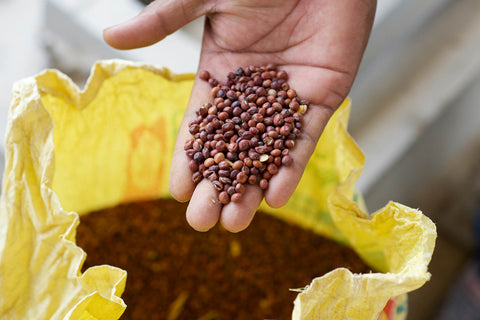
Whole toor (arhar) dal at the magan Khadi processing unit, march 2022
I wish I’d had my camera out when I met one of the cotton farmers – he had a shock of silver hair, which contrasted beautifully with the square cut multi-pocket forest green suit that he was wearing, a broad grin, and more energy than you could imagine - he came bounding into the room to say hello. I can't wait to go back and document the farmers and their commitment to organic farming!
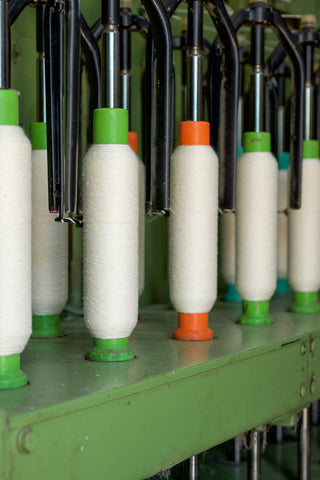
organic cotton sliver machine at Magan Khadi processing unit, near Wardha, Maharashtra (pre-spinning), march 2022
I was also able to step for the first time into a cotton field – at 42 degrees, we hopped out of the car, strolled into the field, shaded from the sun with shawls over our heads, grabbed a few videos and images of the few remaining flowers and cotton bolls, as the cotton had already been harvested, and got right back into the car again and picked up some kulfi (similar to an ice cream bar) at the next village.
Cotton is grown and harvested bi-annually, I must go back before the cotton is harvested next time! Many thanks to Mukesh ji for showing me around and sharing his excitement for slow made textiles, and Abhijeet ji for organizing my stay.
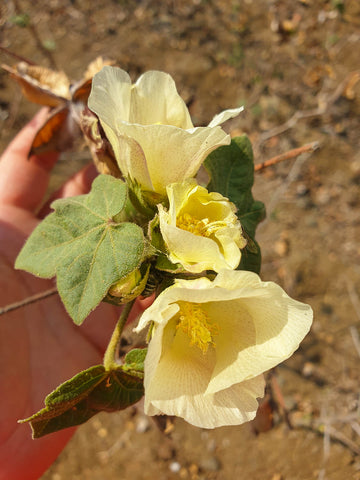
organic cotton flower in a field near Wardha maharashtra, march 2022
Walking into a cotton field for the first time was an emotional experience. After years of reading about cotton farming in India, what it felt like to finally stand on that soil, take in the landscape and breathe the air cannot be described. I can say that it strengthened my resolve to find ways to incorporate organic and indigenous cottons produced by small-scale farmers in India into our clothing, and to share why it is important to do so.
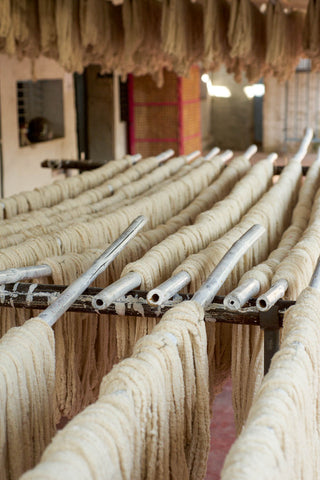
washed handspun organic cotton yarn at magan khadi, wardha, maharasthra, march 2022
There is a long history of issues that arose with the introduction of American cotton varieties to Indian farmland by the British in the 1800s, to GMO varieties introduced in the early 2000's that have been touted as being high yield, pest and drought resistant, often with disastrous results.
Indigenous cotton varieties, many of which have been lost, including those that were spun and woven into the finest muslins ever known, have been cultivated since 3000 BCE in India. These days, indigenous rainfed varieties make up less than 1% of all cotton in India, while organically grown cotton is around 2%.That means that approximately 97% of all cotton farmed in India is genetically modified.
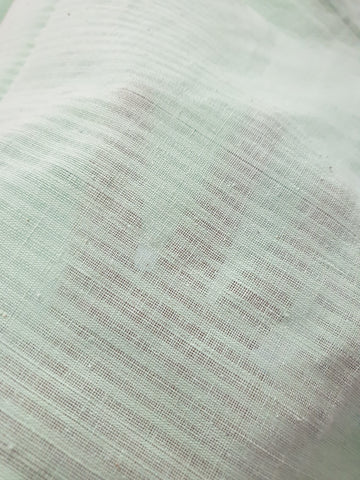
handwoven indigenous cotton fabric sample - kaskom - march 2022
If you’d like to learn more about the history of cotton in India, I would recommend the following books. A Frayed History: The Journey of Cotton in India, by Meena Menon and Uzramma, and Empire of Cotton: A Global History by Sven Beckert.

Mukesh ji showing me some cotton seed, near Wardha maharasthra, march 2022
I had an amazing time at Magan, and brought a batch of hand picked shawls with me for our Markets – all naturally dyed, and of course handwoven, and all produced from seed to weave within a 60km radius.
I’ll pop some of them up on the website when our Summer collection launches. I was pleased to see that the textured undyed shawls were most popular at a recent market - the story of the soil, the seed, spinning and weaving - cotton in its least processed form, from seed to weave, seemed to call out to people the loudest.
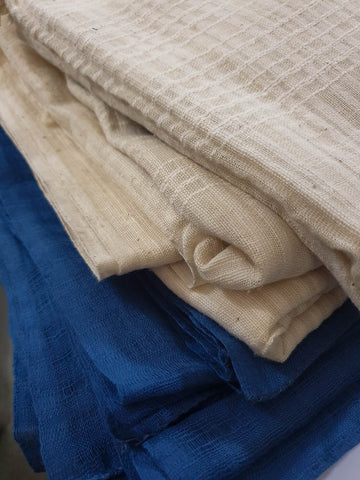
handspun handwoven shawls at magan khadi, wardha, maharashtra in natural indigo and undbleached organic cotton, march 2022
After Wardha, I took an overnight flight from Nagpur to Chandigarh, Punjab, and then took a cab the twisting and turning eight plus hours to Naggar, where our knitwear partners live, in the mountains of Himachal Pradesh. I saved this visit for last, because it was a sensible temperature after the 39-42 degree weather of the plains.
I didn’t know my ankles and face could puff up like that! Thankfully after a good night’s sleep, in the fresh cool mountain air, I could see my ankles again.
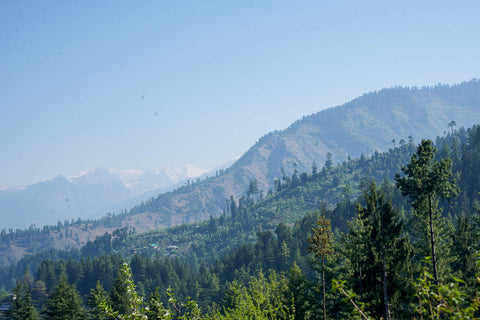
mountain and forest views around naggar, himachal pradesh, april 2022
I can’t describe the feeling of meeting with the women of Kullvi WHIMS after such an unexpectedly long time. We had last visited in August 2019, and had planned to come back each year.
When we spotted each other, it was a strange sense of shyness, heart blooming, teariness, excitement, happiness – big smiles all around. We spent the week working on new designs, I helped them with a few new techniques including seam finishing and various methods of colour blending, and we went on the craziest bus trip/picnic where they danced in the centre of the bus as we careened around narrow twisting dirt roads on the highest cliffs to the pulsing triplet rhythms of Himachali music.
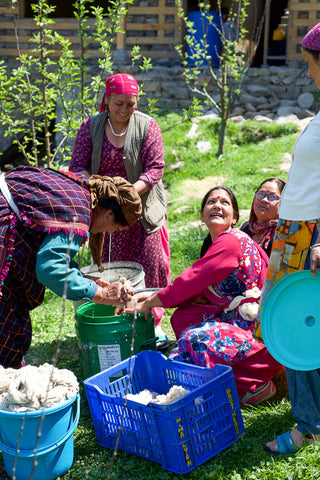
From left to right: Teji Devi, Neema, Yogbanti, Indra and vandana, rinsing handspun wool for dyeing, april 2022
One of the most exciting aspects of the trip, was the fact that we managed to close the loop on our wool supply chain.
After leaving the ladies in the village of Udaipur for their picnic lunch I, Nisha, our collaborator and Brighu, owner of Himalayan Brothers Adventures, a local trekking company and homestay, continued onwards.
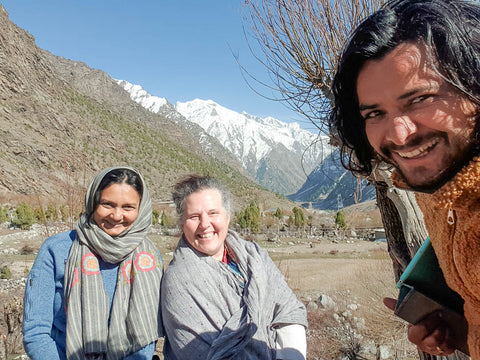
Nisha Subramaniam of Kullvi WHIMS, Sarah from Rani & Reine and Brighu from Himalayan Brothers Adventures.
We drove to a small village of 226 inhabitants in the Miyar Valley, about an hour from Udaipur. It was about 5 hours total drive from Naggar, but just 150 kms. We drove up and up, climbing higher into the mountains in the Lahaul Spiti region. The landscape shifted as we rose, becoming more and more beautiful and pristine. We finally arrived at our homestay at around 5 PM.
view from the homestay of the valley below, april 2022
Kullvi WHIMS had already sourced 500kgs of wool from the shepherds in the area, but had yet to visit in person. The local indigenous breed of sheep had been crossbred with merino in the 60s, producing a soft wool suitable for next-to-skin garments such as our shawls, mittens, and hats.

Lahauli sheep being led up into the hills to graze for the day in the Miyar Valley, Himachal Pradesh, April 2022
Securing a sustainable and dependable source for our wool has been difficult, especially as the need for wool has increased as Kullvi WHIMS products have become popular. Apart from many other challenges, up until October 2020 when a tunnel was built, Lahaul was landlocked and inaccessible during a large part of the year due to weather, high mountain passes and rugged roads.
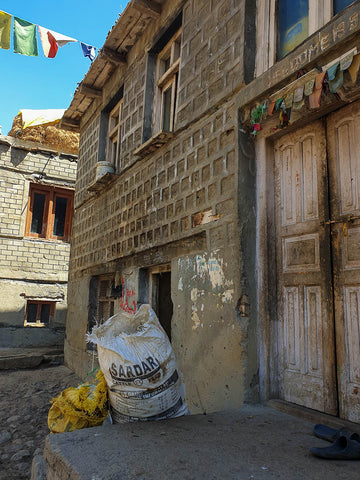
Purchasing brown wool in the miyar valley, himachal pradesh, april 2022
I was incredibly lucky to have managed to be there at the right time of year when the sheep were still in the village and not on their yearly trek through the mountain tops, that Nisha's continued work with Kullvi WHIMS had resulted in a partnership with this group of shepherds, and that Brighu was available and willing to take us.
I'll write a more detailed version of the story in the Fall when we launch our next collection of woollens, I've got many stories and so many photos and films - but the overnight trip included a bout of altitude sickness (approximately 3300m), a pristine valley amongst soaring mountains, bright sun, fresh air and water, cackling ladies loudly bartering, knitting and drinking the local moonshine, Buddhist prayer flags, the sunshiny-est homestay room, home-cooked food, locally grown sea-buckthorn tea and most importantly, a parade of sheep being led up into the mountain meadows via narrow paths throughout the small village, in herds of 10-30 or more, bells ringing as they went, followed by the local shepherds and shepherdesses.

the sheep that provide the wool for our garments spend the winter in a village of 226 inhabitants in the Lahaul-Spiti region of Himachal Pradesh, April 2022
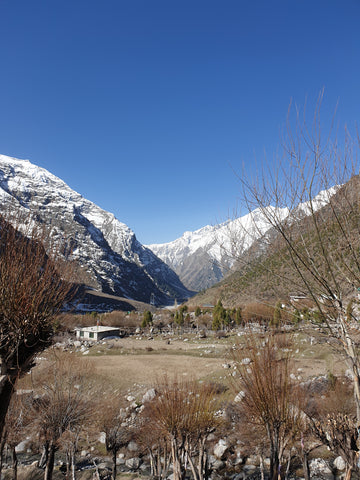
The Miyar Valley, April 2022
A few days after returning back to Naggar from our trek into the remote Miyar Valley, I took a cab the 15 hours to Delhi with a couple from Sweden, spent the next day in the crazy heat (literally frying my phone into not working) for a day of shopping; buttons at Sadar Bazar for something special coming in the Fall, as well as for one of our summer dresses, a visit to a silver shop in Chandni Chowk, then Anokhi (and cake) at Khan market, and, instructed to buy pirate rings for my youngest son – thankfully found some in Dilli Haat, a quick dinner of momos, zoomed to the sweet shop to pack up 2 kgs of sweets, and then to bed before packing and coming home to the shock of 4 degrees and rain.
I cannot end this without saying that I would not have been able to take this trip, and zoom around to so many places in such a short time without the support of my husband and co-founder Arindam, who took over all home, school and extra-curricular tasks and kept everything under control for 3+ weeks! Not to mention the occasional whatsapp voice messages I played out loud to amused cab and uber drivers in Hindi ;)
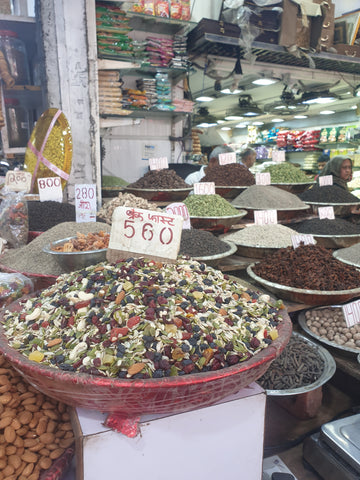
Nuts, dried fruit and spices at the Old delhi spice market, April 2022


1 comment
Beautifully written! Enjoyed reading about your journey! May your work grow and impact lives on many artisans across the country! Thank you for sharing these stories